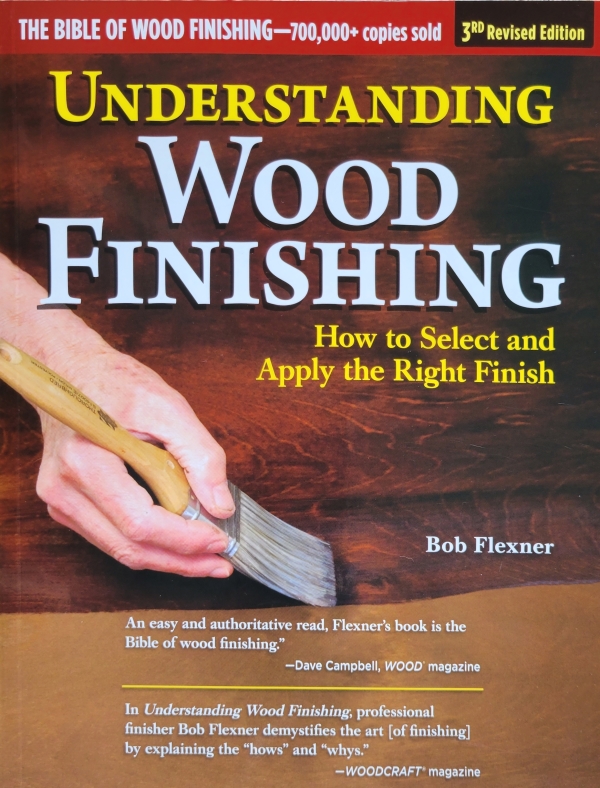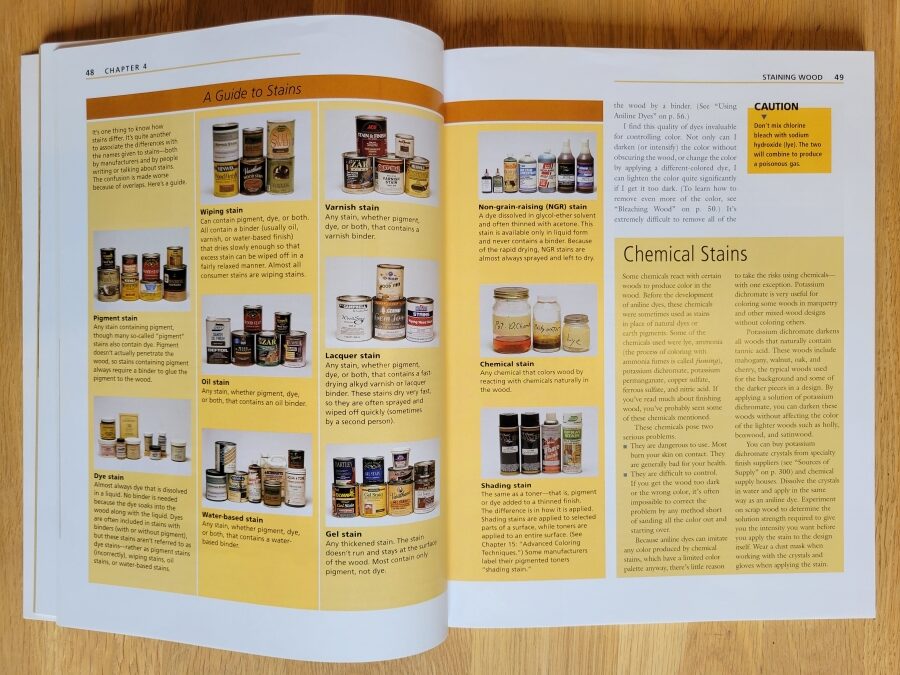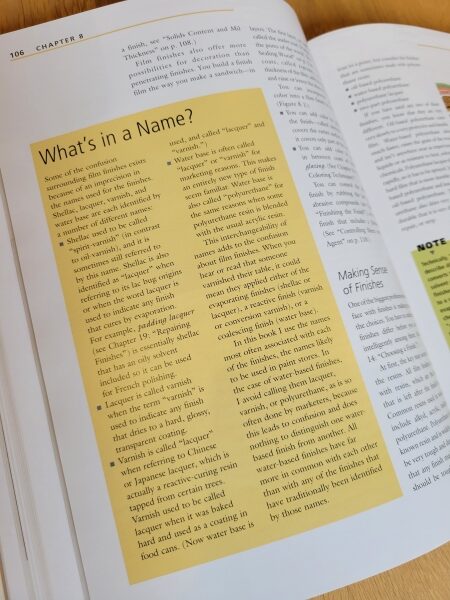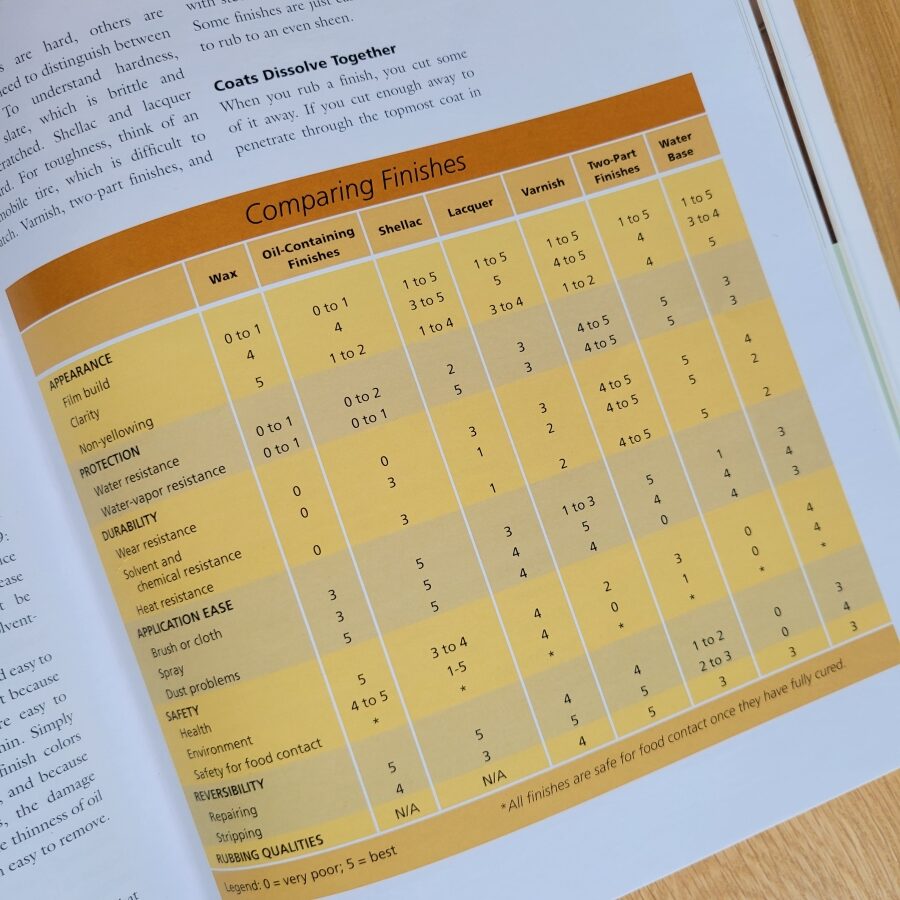
The third woodworking book review in my Woodworking Book of the Month Series is all about wood finishes. It is often referred to as the bible of wood finishing. Today I’m reviewing Understanding Wood Finishes: How to Select and Apply the Right Finish (3rd revised edition, 2021) by Bob Flexner.
About the Book
Immediately upon opening the book cover and reading through the extensive table of contents, I could tell that this book had a lot to offer.
The title of this woodworking book says it all: the entire book is dedicated to understanding wood finishing. Specifically, it covers everything from preparing the wood, to applying the finish, maintaining and repairing it. In addition, it goes into multiple types of finishes including penetrating finishes (oil) and film finishes (varnish, shellac, lacquer, water base). The book also touches on more advanced topics, such as coloring techniques, spray application, wax finishes and pore filling.

The author, Bob Flexner, is a best-selling author of several woodworking titles. You may also know him from Popular Woodworking magazine, where’s he’s a regular contributor. In fact, he’s been writing about wood finishing for over 30 years. Indeed, the first edition of Understanding Wood Finishes was published in 1994… more than 25 years ago!
In spite of the recent 3rd revision in 2021, I was concerned that the book might be outdated. However, I was wrong. Mostly. While most of the updated info is relevant today, the one type of finish I found to be missing: hardwax-oil. Personally, I have become a big fan of these products, like Osmo Polyx-oil.
Understanding Wood Finishing | Book Review
What I Liked About the Book
First off, this book is probably the most comprehensive you’ll ever find on the subject. In fact, you may find it provides too much information, especially if you’re a beginner. The depth and complexity of the finishing world can at times be overwhelming.
That being said, after reading this book you’ll have a clear understanding of the differences between oil, varnish, shellac and lacquer, and which is better for what. In addition, you’ll likely be convinced that Linseed oil sucks! Moreover, you’ll understand why gel stains are best for use on blotchy woods like pine, and why pine is actually the most difficult wood to finish. You’ll also be surprised to learn that most finishes are actually “food safe” once fully cured, contrary to popular belief.

The book is split up into clearly delineated chapters, which makes it easy to come back to when you’re ready to dive into a finish on a given project. In addition to the solid foundation of each chapter, the book is full of framed tips and reference charts that really add value. There are also often pictures of products shown as examples of the finish being discussed that can help you relate. However, with the book being written by an American author, you may not have the same products available where you live.
What I Didn’t Like About the Book
Not to be picky but… I consider myself an intermediate level woodworker, but I’m definitely a beginner when it comes to finishing. As a matter of fact, I tend to stay away from stains and typically use polyurethane or Osmo Polyx-oil on almost every project. With that said, I often found myself somewhat confused while reading this book. There’s almost too much information, which can make it overwhelming to take in all at once.
The Biggest Issue With Wood Finishes
My biggest deception with this book, through no fault of the author himself, was to learn that almost all commercial finishes are misleading and falsely labeled. So even if I was able to internalize all the knowledge the author is sharing, I would still have a difficult time actually purchasing the specific type of stain or finish I want.
For example, in chapter 4 which is all about staining, we are introduced to dye vs. pigment stains. Then the author goes into the benefits and drawbacks of each type of stain: pigment stains are better at resisting fading from sunlight, but dyes will color the wood more evenly. Ok great, but…
The truth of the matter is that manufacturers seldom disclose what type of colorant they use in their stains. As such, you may have 3 shades of Minwax stain with identical looking cans, but one may be pigment, the other dye, and the last one a mix of both. Ultimately, the only way to know for sure is to scrape the bottom of the can with a stir stick and see what’s left on your stick!

In the author’s defense, it’s not really his fault. The real issue, as he points out in the book, is that wood finishes make it almost impossible to know what’s really in the can. You may think you’re buying Tung Oil – it says so right there on the label – but it’s not Tung oil at all. Not even a single drop in some cases. Danish oil is actually a an oil/varnish blend. Shellac may be identified as Lacquer, while Lacquer may be called varnish. How is one to know the difference!?
The author does provide several tips for this, but ultimately I now feel that selecting a wood finish off the shelf is the equivalent of shopping with a blindfold on.
Book Review: The Verdict
Ultimately, there is now doubt that you will learn a lot about wood finishing in this book. In fact, you’ll likely learn more than you even expected about techniques you may not have even known about. Some chapters will be more relevant to beginners, while others definitely fall in the advanced finishing techniques realm.

On the other hand, as a beginner, you may be left still confused in the end. With so many finishes to choose from, it’s hard to know where to start. Unfortunately, the author failed to provide a clear decision-tree type of guide to help lead beginners in their finishing choices. It would have been helpful to have a few typical project examples with an explanation of which stain/sealant/finish/etc. was selected and why, and how they all fit together. There is a chapter about finishing different woods, but it fell a little short in my opinion.
Bottom line: there is no doubt in my mind that this book is the most complete reference available today, and should definitely be part of every aspiring woodworker’s library. Even though, at the very end of the book when I had finished, I was left feeling like I would after watching one of those movies. You know, the ones where you’re pretty sure you’d understand a whole lot better if you just watched it all over again.
Pros & Cons of This Book
Pros
- Comprehensive & unparalleled resource on wood finishing
- Helps the user understand how each finish works with the advantages and drawbacks of each
- Well defined chapters that allow you to come back to the info you need
Cons
- Can be overwhelming and somewhat confusing
- Lacks practical decision making guidance on which finish to use and when
- Does not cover newer finishes, such as hardwax-oil (Osmo Polyx-oil, Rubio Monocoat)

Understanding Wood Finishes: How to Select and Apply the Right Finish by Bob Flexner.
Paperback, 11″ x 8-1/2″, 320 pages
3rd revised edition, published March 2021
The next book I’ll be reading is all about bandsaws! Truthfully? I bought my first band saw about a year ago and I’ve only used it a few times. It’s an unfamiliar tool to me and I’m still trying to figure out how to better integrate it into my builds. As such, next month I’ll be reading the New Complete Guide to Band Saws Everything You Need to Know About the Most Important Saw in the Shop. You can read the full review here.

1 comment on “Understanding Wood Finishing | Book Review”